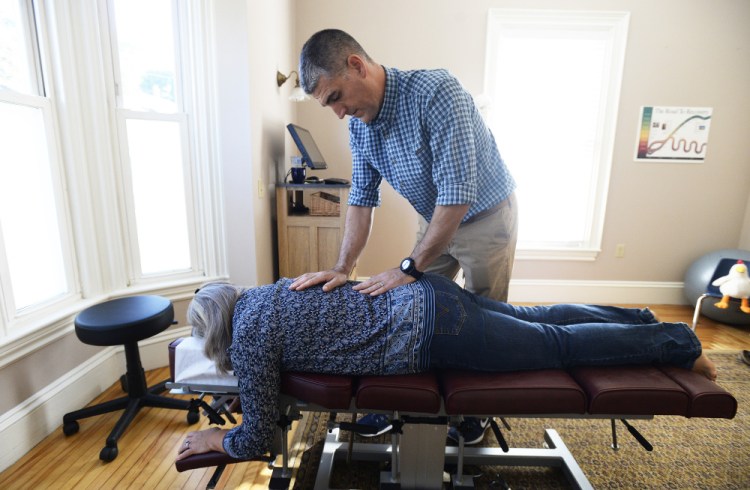Debra Labbe, 56, has devised a comprehensive strategy to treat chronic back pain related to her job as a nurse at Maine Medical Center in Portland.
She sees a chiropractor, exercises, stretches, builds up her core muscles, spends time in her hot tub and sparingly takes ibuprofen.
She’s far from alone, as back injuries are the most common non-fatal occupational injury, according to the U.S. Bureau of Labor Statistics.
In 2014, there were about 200,000 cases where employees missed at least one day of work due to a back injury, out of 1.15 million total cases of occupational missed time for injuries, according to a 2015 report released by the Bureau of Labor Statistics. After back injuries, workers most commonly hurt their hands and knees. Sprains, strains and tears were the most common types of injuries.
In Maine, it’s only getting worse. According to Maine Department of Labor data, injuries to a person’s lumbar region were the most reported occupational injury in 2014, representing 14.3 percent of all injuries. Five years earlier, back injuries were 10.7 percent of occupational injuries.
Health care employees have among the highest rates of injuries for workers, second only to those working in the transportation and warehousing sectors.
“There’s a lot of stress on the body on the job,” said Labbe, of Raymond, explaining that she wears heavy lead aprons when patients are having radiation treatments, and she needs to move patients and equipment.
Labbe said her work, running and hiking have put stress on her back, and the chiropractic care along with the other techniques controls her pain. She said she never got an injury, but as she’s aged the back pain has worsened.
Since she started her treatment regimen this winter, her pain has improved.
“I have noticed a big difference,” said Labbe, who recently received a lower back manipulation by Robert Lavoie at his Gorham chiropractic clinic.
Lavoie said he sees many cases related to occupations, but not just the blue-collar jobs that the public associates with injuries – such as lobstermen, construction workers or plumbers.
“The body was not meant to sit in front of a computer for eight to 10 hours a day,” Lavoie said.
Lavoie said sedentary workers are often surprised to learn that they are susceptible to back injuries or chronic back pain.
“They’re getting all of these aches and pains and wondering why,” he said.
Lavoie recommends ergonomics – having the computer monitors at the correct height, for instance, or work stations that give employees the choice to sit or stand throughout the work day.
But he said frequent breaks are also helpful. If possible, take a short walk away from the computer monitor every hour.
For workers who do physical labor, proper lifting technique is important, but so is good nutrition and sleep, strengthening core muscles, exercise, massage and yoga. Wearing a brace can also be helpful.
“It’s not any one thing that we do. We have to treat the whole body,” Lavoie said.
He said at any job, be careful to avoid repetitive, unnatural body movements, such as excessive twisting or even constantly looking down while texting on a cellphone.
“We call that ‘text neck,’ ” Lavoie said.
Lavoie said chiropractors are seeing more patients who formerly were on opioids now that there’s more realization of their dangers. Maine had a record 272 drug overdoses in 2015 – most caused by opioids – and is on pace to exceed that record in 2016. Lavoie said patients and doctors are searching for alternatives to opioids to treat chronic pain. There have not been any long-term studies that prove the effectiveness of opioids in treating chronic pain, according to the U.S. Centers for Disease Control.
Lavoie said medication has a place, but it should be used in conjunction with other treatments and not as the primary way to treat pain.
“All the drugs do is mask your pain. It is not treating the underlying conditions, the reasons why you are having pain,” he said. q
Send questions/comments to the editors.




Comments are no longer available on this story